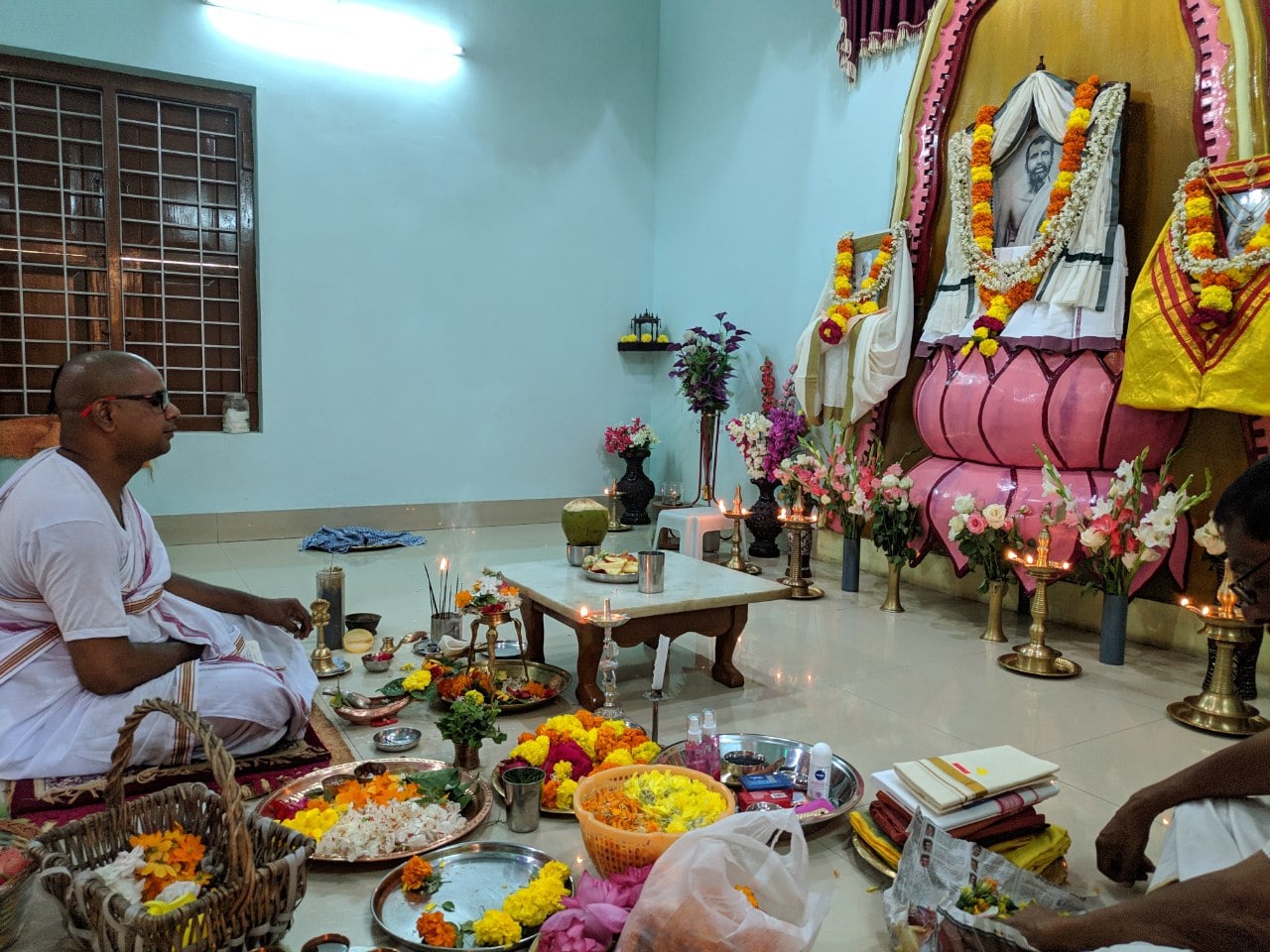ഒരു ഹ്രസ്വ ചരിത്രം

രാമകൃഷ്ണ മഠവും രാമകൃഷ്ണ മിഷനും ലോകമെമ്പാടുമുള്ള, ഒരു നൂറ്റാണ്ടിലേറെയായി വിവിധ മാനുഷിക, സാമൂഹിക സേവന പ്രവർത്തനങ്ങളിൽ ഏർപ്പെട്ടിരിക്കുന്ന, രാഷ്ട്രീയേതര, വിഭാഗീയതയില്ലാത്ത ആത്മീയ സംഘടനകളാണ്. പരിത്യാഗത്തിൻ്റെയും സേവനത്തിൻ്റെയും ആദർശങ്ങളിൽ നിന്ന് പ്രചോദനം ഉൾക്കൊണ്ട്, മഠത്തിലെയും മിഷനിലെയും സന്യാസിമാരും സാധാരണ ഭക്തരും ജാതി, മത, വർഗ്ഗ വ്യത്യാസമില്ലാതെ ദശലക്ഷക്കണക്കിന് പുരുഷന്മാരെയും സ്ത്രീകളെയും കുട്ടികളെയും സേവിക്കുന്നു, കാരണം അവർ തങ്ങളിൽ ജീവിക്കുന്ന ദൈവത്തെ കാണുന്നു.
ആധുനിക യുഗത്തിൻ്റെ പ്രവാചകനായി കണക്കാക്കപ്പെടുന്ന ബംഗാളിൽ നിന്നുള്ള 19-ആം നൂറ്റാണ്ടിലെ മഹാനായ ശ്രീരാമകൃഷ്ണനും (1836-1886) ശ്രീരാമകൃഷ്ണൻ്റെ പ്രധാന ശിഷ്യനുമായ സ്വാമി വിവേകാനന്ദനാണ് ഈ സംഘടനകൾ നിലവിൽ വന്നത്. (1863-1902), ഇന്നത്തെ യുഗത്തിലെ മുൻനിര ചിന്തകരിൽ ഒരാളും മതനേതാക്കളിൽ ഒരാളും, 'ആധുനിക ലോകത്തെ പ്രധാന അച്ചിൽ ഒരാളായി' കണക്കാക്കപ്പെടുന്നു, ഒരു പ്രമുഖ പാശ്ചാത്യ പണ്ഡിതനായ എ.എൽ. ബാഷാമിൻ്റെ വാക്കുകളിൽ.
രാമകൃഷ്ണമഠവും രാമകൃഷ്ണ മിഷനും നിയമപരമായും സാമ്പത്തികമായും വേറിട്ടതാണെങ്കിലും അവ പല തരത്തിൽ പരസ്പരം ബന്ധപ്പെട്ടിരിക്കുന്നു; ഇരട്ട സംഘടനകളായാണ് അവ കണക്കാക്കപ്പെടുന്നത്.
ഈ ഇരട്ടസംഘടനകൾ വിഭാഗീയമല്ലാത്തതും വിശ്വജനീനവുമായ ഒരു ആത്മീയപ്രസ്ഥാനത്തിന് രൂപം നൽകിയിരിക്കുന്നു. അവ മനുഷ്യരാശിയുടെ ആത്മീയപുനരുജ്ജീവനത്തിനായി നൂറിലധികം വർഷങ്ങളായി നിശബ്ദമായി പ്രവർത്തിക്കുന്നു.
വേദാന്തം എന്നറിയപ്പെടുന്ന ഇന്ത്യയുടെ പുരാതനമായ മതതത്ത്വചിന്തയാണ് നടന്നുകൊണ്ടിരിക്കുന്ന ഈ പരിവർത്തനത്തിന്റെ മുഖ്യമായ ഉൽപ്രേരകം. ഇന്ത്യയിൽ വ്യത്യസ്തസമയങ്ങളിൽ മറ്റ് പല തത്ത്വചിന്തകളും ഉയർന്നുവന്നിട്ടുണ്ടെങ്കിലും അവയെല്ലാം ചെറുസംഘങ്ങളിൽ ഒതുങ്ങിയിരുന്നു. വേദാന്തംമാത്രം വേദകാലംമുതൽ ഇന്നുവരെ ഇന്ത്യയുടെ മതപാരമ്പര്യത്തിന്റെ പ്രബലമായ തത്ത്വചിന്തയായി തുടരുന്നു. ഈ പുരാതനതത്ത്വചിന്ത ആധുനികകാലത്ത് ശ്രീരാമകൃഷ്ണനാൽ ശുദ്ധീകരിക്കപ്പെടുകയും ഏകീകരിക്കപ്പെടുകയും ഊർജ്ജസ്വലമാക്കപ്പെടുകയും ചെയ്തും, സ്വാമി വിവേകാനന്ദനാൽ ആധുനികഭാഷയിൽ വിശദീകരിപ്പെടുകയും ചെയ്തും, ജാതി-മത- വർഗ്ഗവിവേചനങ്ങൾ കൂടാതെ ലോകമെമ്പാടുമുള്ള എല്ലാ ആളുകൾക്കും ലഭ്യമാക്കിയിരിക്കുന്നു.
രാമകൃഷ്ണപ്രസ്ഥാനം മതപരിവർത്തനത്തിൽ വിശ്വസിക്കുന്നില്ല, ഗുപ്തവിദ്യയിലോ ഉദ്വേഗജനകമായ കാര്യങ്ങളിലോ ഏർപ്പെടുന്നില്ല. വ്യക്തിപരമായ ആത്മീയവികാസത്തിനും നിസ്വാർത്ഥസേവനത്തിനും പ്രസ്ഥാനം വളരെയധികം പ്രാധാന്യം നൽകുന്നു. എല്ലാ മതവിശ്വാസങ്ങളുടെയും ആത്യന്തികമായ ഐക്യമെന്ന ആശയത്തിൽനിന്ന് പ്രചോദനം ഉൾക്കൊണ്ട്, രാമകൃഷ്ണപ്രസ്ഥാനത്തിന്റെ വിവിധകേന്ദ്രങ്ങൾ സൗഹൃദത്തിന്റെയും പരസ്പരമുള്ള അംഗീകാരത്തിന്റെയും ഭാവത്തിൽ മറ്റുള്ളവരെ കാണാനും സ്വന്തം വിശ്വാസം ഉപേക്ഷിക്കാതെതന്നെ പരസ്പരം പഠിക്കുന്നതിനും വിവിധമതക്കാരെ പ്രോത്സാഹിപ്പിക്കുന്നു. ശ്രീരാമകൃഷ്ണന്റെ വാക്കുകളിൽ പറഞ്ഞാൽ: “വ്യത്യസ്തസാധകർക്കും ജീവിതരീതികൾക്കും ദേശങ്ങൾക്കും ചേരുന്ന വിധത്തിൽ ഈശ്വരൻ വ്യത്യസ്തമതങ്ങളുണ്ടാക്കിയിരിക്കുന്നു. ഓരോ സിദ്ധാന്തവും ഓരോ വഴിയാണ്; എന്നാൽ വഴി ഒരിക്കലും ഈശ്വരനല്ല. സത്യം പറഞ്ഞാൽ, പൂർണ്ണഹൃദയത്തോടെയുള്ള ഭക്തിയോടെ ഏതു വഴി പിന്തുടർന്നാലും തീർച്ചയായും ദൈവത്തിൽ എത്തിച്ചേരാനാകും. ”
മുദ്രാവാക്യം: എന്നതാണ് ഇരട്ട സംഘടനകളുടെ മുദ്രാവാക്യം ആത്മനോ മോക്ഷാർത്ഥം ജഗദ് ഹിതായ ച, "സ്വന്തം രക്ഷയ്ക്കും ലോകത്തിൻ്റെ ക്ഷേമത്തിനും വേണ്ടി". സ്വാമി വിവേകാനന്ദനാണ് ഇത് രൂപപ്പെടുത്തിയത്.
ആരാധനയായി പ്രവർത്തിക്കുക, ആത്മാവിൻ്റെ സാധ്യതയുള്ള ദൈവികത, മതങ്ങളുടെ ഐക്യം എന്നിവ ഈ രണ്ട് സംഘടനകളും അടിസ്ഥാനമാക്കിയുള്ള ശ്രദ്ധേയമായ മൂന്ന് ആശയങ്ങളാണ്. നിരവധി ആശുപത്രികൾ, ഡിസ്പെൻസറികൾ, മൊബൈൽ മെഡിക്കൽ യൂണിറ്റുകൾ, സ്കൂളുകൾ, കോളേജുകൾ, ഗ്രാമവികസന കേന്ദ്രങ്ങൾ തുടങ്ങി നിരവധി സാമൂഹിക സേവന സ്ഥാപനങ്ങൾ ഇരട്ട സംഘടനകൾ നടത്തിവരുന്നത് ദൈവസേവനമെന്ന നിലയിൽ മനുഷ്യനോടുള്ള ഈ ആദർശമാണ്.
രാമകൃഷ്ണ മഠത്തിൻ്റെയും രാമകൃഷ്ണ മിഷൻ്റെയും ആസ്ഥാനം ഇന്ത്യയിലെ പശ്ചിമ ബംഗാളിലെ ഹൗറ ജില്ലയിൽ ബേലൂർ എന്ന സ്ഥലത്താണ് സ്ഥിതി ചെയ്യുന്നത്. ആസ്ഥാനത്തിൻ്റെ മുഴുവൻ കാമ്പസും 'ബേലൂർ മഠം' എന്നാണ് അറിയപ്പെടുന്നത്. ഹൂഗ്ലി നദിയുടെ (ഗംഗ) പടിഞ്ഞാറൻ തീരത്ത് നാൽപ്പത് ഏക്കറിലധികം സ്ഥലത്ത് പരന്നുകിടക്കുന്ന ഈ സ്ഥലത്തേക്ക് കൊൽക്കത്തയിൽ നിന്ന് ഒരു മണിക്കൂർ യാത്രയുണ്ട്.
ചിഹ്നം സ്വാമി വിവേകാനന്ദൻ രൂപകല്പന ചെയ്ത രാമകൃഷ്ണ ക്രമം, സമകാലിക ചരിത്രത്തിലെ ഏറ്റവും ധനികരായ മനസ്സുകളിലൊന്ന് ആത്മീയ പ്രചോദനത്തിൻ്റെ ഉയർന്ന മാനസികാവസ്ഥയിൽ സൃഷ്ടിച്ച അതുല്യവും സമാനതകളില്ലാത്തതുമായ ഒരു കലാസൃഷ്ടിയാണ്. സംഘട്ടനത്തിൻ്റെയും പൊരുത്തക്കേടിൻ്റെയും ഈ കാലഘട്ടത്തിൽ ഭക്തിനിർഭരമായ ധ്യാനത്തിനുള്ള ഐക്യത്തിൻ്റെയും സമന്വയത്തിൻ്റെയും അഗാധമായ പ്രതീകമാണിത്. ഈ ചിഹ്നം സ്വാമിജിയുടെ യോജിപ്പിൻ്റെയും സമന്വയത്തിൻ്റെയും സന്ദേശത്തിൻ്റെ പ്രതീകമാണ്, ഇത് ജീവിതത്തിൻ്റെ പൂർത്തീകരണത്തിലേക്ക് നയിക്കുന്നു. കിഴക്ക് അല്ലെങ്കിൽ പടിഞ്ഞാറ്, ഓരോ പുരുഷനും സ്ത്രീയും എന്തായിരിക്കണമെന്ന് അദ്ദേഹം ആഗ്രഹിച്ചതിൻ്റെ ഏറ്റവും വാചാലമായ പ്രകടനമാണിത്. ഈ ജീവിതത്തിൽ പോലും, ഒരാളുടെ യഥാർത്ഥ സ്വയം, സ്വയം പ്രകാശിക്കുന്ന ആത്മാവ്, ചിഹ്നത്തിലെ ഹംസം, ഈ തിരിച്ചറിവിലൂടെ എല്ലാ പരിമിതികളിൽ നിന്നും എല്ലാ ബന്ധനങ്ങളിൽ നിന്നും എല്ലാ കുറവുകളിൽ നിന്നും മുക്തനാകുക എന്നതാണ് ലക്ഷ്യം. ഈ ആത്മീയ സ്വാതന്ത്ര്യം ഈ ജീവിതത്തിൽ തന്നെ ആഗ്രഹിക്കുകയും നേടുകയും ചെയ്യേണ്ട ഒന്നാണ്. പരിമിതമായ വ്യക്തിത്വമുള്ള ഒരാളുടെ തടവറയിൽ നിന്ന് അത് ഒരാളെ മോചിപ്പിക്കുകയും സാർവത്രിക അസ്തിത്വത്തിൻ്റെ അനുഗ്രഹമായി അവനോ അവൾക്കോ നൽകുകയും ചെയ്യുന്നു. അപ്പോൾ അവൻ അസ്തിത്വം-അറിവ്-ആനന്ദം സമ്പൂർണ്ണതയിൽ ഒന്നായിത്തീരുന്നു. തുറന്ന മനസുള്ളവരായിരിക്കുക. ഇതാണ് മുഴുവൻ മതവും സ്വാമിജി പറഞ്ഞു. ഈ ചിഹ്നത്തിൻ്റെ പിന്നിലെ അർത്ഥം, വിവേകാനന്ദൻ്റെ ഭാഷയിൽ തന്നെ:
‘ചിഹ്നത്തിലെ തരംഗിതമായ ജലം കര്മ്മയോഗത്തെയും താമരപ്പൂവ് ഭക്തിയോഗത്തെയും, ഉദിച്ചുയരുന്ന സൂര്യന് ജ്ഞാനയോഗത്തെയും, ചുരുണ്ടിരിക്കുന്ന സര്പ്പം രാജയോഗത്തെയും പ്രതിനിധാനം ചെയ്യുന്നു. അതിലെ ഹംസം പരമാത്മാവിനെ കുറിക്കുന്നു. നാലു യോഗങ്ങളുടെ ഒരുമിച്ചുള്ള അഭ്യസനത്താല് പരമാത്മാവിനെ സാക്ഷാത്കരിക്കാന് കഴിയുന്നുവെന്നാണ് മുദ്രയുടെ അര്ത്ഥം.’

